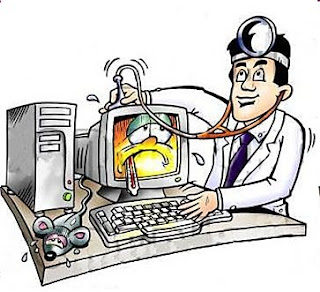If you own a computer then you must have a good knowledge of formatting your computer.Formatting a computer refers to installing an operating system with or without deleting the contents in the drive.Do not worry it is not so difficult like it sounds.Here i will teach you how to format your computer along with the partition of your hard disk ^ _ ^ But firstly i want to point out the situations when a computer needs formatting.So here they are ::
1.If your computer's program files are infected with viruses and the computer runs slow as a slug.Yeah the antivirus program will help to disinfect the infected files but still it so happens sometimes that your main operating system gets infected and the antivirus program if can not disinfect, will delete the whole files.Therefore your computer will show many error messages and will run so slow.
2.If you need to try out the new operating system or wanna use the older one.And if you have just bought a new hard disk.Well these are obvious reasons...But still i wanna point out.
3.Sometimes due to sudden or often power cut, it may cause to damage your system files so your computer might not restart properly or may restart slower then usual.Sometimes it will only show the logo and will restart again and will stuck on the logo.
Now come to the main point...Here i will describe you the process step by step to format a computer using windows Xp/Vista/7/8 along with the partition of your hard drive.
1.First of all know your computer configuration,that is it's RAM,Processor,Graphic Card And the Motherboard. Now,read the requirements needed to install the operating system you are planning to install i.e either windows Xp or vista or 7 or 8.It will on the back of the CD cover or you can check the official site.But remember Windows Xp is still the best,I mean if you need a faster running computer and need to install more applications and software Windows Xp is the best..But if you prefer greater graphic display and good looking computer along with some cool customization features then Windows 7 is the best.But Windows 7 may show some errors on some software because it may not support like windows xp can.I won't recommend you to install Vista.Windows 8 is just a cheap copy of windows 7(has not been released a complete copy yet).
2.After knowing the configuration of your computer and the requirements needed to install the operating system,check that if your computer meets the minimum requirements needed to install the operating system.If it does then you are ready to install it ^_^ Now note the serial key that may be on the back of your windows CD cover as well.But if you got a CD without any cover or if you could not find it on the back of the cover or if you are planning to format your computer via USB disk/pen drive then you need to open them in a working computer and there you might find the serial key in a text file.Note it on a paper.If you did not find it anywhere then just leave it.
3.Now you are almost ready to format your computer.(You can skip this part)Turn on your computer and press Esc button to display your BIOS settings.Check whether the boot first device is set to CD/DVD disk if you are going to use DVD to format or Removable disk if you are going to use a USB disk/pen drive to format your computer.If not then set it as the first priority then save it and hit exit.The computer will restart.Open the CD/DVD drive and place the CD/DVD or plug in the pen drive/USB disk.And restart again.
4.Now most of the computer will detect the setup file automatically and you will see a comman like "Boot from DVD/CD....."If you see this message then press any key immediately because it will just show this for about 2-5 seconds.
If your computer do not show such commands or messages then this means that your BIOS could not detect the setup file.In this case restart again and try pressing any of these keys F2 /F11 /F12 /Delete Now a different window will appear showing the boot options press CD/DVD option if you are planning on using a CD/DVD or Removable disk option if you are planning to use a USB disk/pen drive.If neither of the keys mentioned worked then try pressing each of the function keys restarting each time if not work..... so that a boot menu option window will appear.
5.Now the setup file will load some system files and a different window will appear where you need to accept the license agreement.Read any other messages that will show carefully and enter it according to your needs.i.e You might be asked to either install a fresh copy or repair the older one(if windows was installed earlier).I recommend you install a fesh copy.You might be asked the time zone and other basic settings enter them according to your need.
6.Now you will be taken to a window where you will be asked in which drive you need to install the operating system. Normally we install an operating system in a C drive.So choose the C drive and hit enter.If you have purchased a new hard disk then you need to partition the hard disk.Also if you are planning to extend the C drive or any drive that is increase or decrease the storage capacity of any drive then you need to partition your hard drive.To partition a hard drive follow these steps:
Remember partitioning of a new drive will delete all the data stored in it.So back up the files before partitioning.
i) Check out your hard disk space or drive space you want to partition.If you want to delete a partition then go to the partition and click D/L button and read the message and hit enter.
ii)Now, to create a partition go to the drive that is showing "unallocated space" or the partition you just deleted and press C.Read the messages carefully and enter according to the need.In windows 7/8 there will be a drive options go there and follow the same process.Please read the messages carefully and enter according to the need.While creating a new partition you will be asked to enter the desired space in the partition.And yeah use NTFS file system if asked because it is the advanced file system and is better then the FAT file system.For that follow these.
8 bits(b) = 1 byte(B)
1024 bytes = 1 Kilobyte(KB)
1024 Kilobytes = 1 Megabyte(MB)
1024 Megabytes = 1 Gigabyte(GB)
1024 Gigabytes = 1 Terabyte(TB)
REMEMBER there is difference between (KB) And (Kb)
KB=Kilobyte
Kb=Kilobits
So KB>Kb
iii)Now after entering the desired space,you will see the new partition on the drive window, go to the partition where you want to install the operating system and hit enter.Leave the other partitions you created you will need to format them after installation of the operating system
7.Now you will be asked whether to leave the file or quick format or deep format in windows xp.I recommend you use the deep format, though it will take more time,it will clean all your disk errors and will copy new and fresh index and system volume files.These options are not available in windows 7/8 so just format the drive by going to the drive options and select format.
8.Now the setup file will format and then copy the required system files and folders to the drive.Your computer will restart several times,do not worry it is just a process.During the installation several messages will pop out,read them carefully and enter them according to the need.Somewhere you will be asked to enter the serial/product key of the operating system.Enter it from the note you have copied earlier in step 2.If you got no product/serial key then just tick the options where "activate when i am online" is shown.You can activate it after the installation of the operating system visiting the official site of it.Read any other messages that will pop up again after entering the serial/product key and enter then depending on your needs.There will come an option where you will be asked whether to enable automatic windows update or not.Enable it as it will update your operating system and hence keep your computer safe and make it faster.
9.Finally your computer will open with the operating system you formatted your computer ^ _ ^
You might see large display in the desktop,do not worry,you need to install the drivers to fix the problem. Wait for a minute then remove the DVD/USB disk and check the drivers of your computer.For this go to the computer in the start menu then right click it then go to manage then to disk manager.If you don't see any yellow colored errors then your computer do not need any driver.But if it does (it will be in most cases while installing Windows Xp or Vista) then you need to install the driver manually.
Now for that you need the driver CD that came up with your motherboard and graphic card if you have an external graphic card.If you got no CDs then go to the official site of your motherboard and the graphic card and download the driver form there.Normally VGA,Chipset,Audio And LAN driver is needed.Install them inserting the CDs or downloading from the site.You can also check the driver over internet,for that right click the drivers that are showing the yellow colored errors then go to update the driver and check ovet the internet.
But i recommend you install them from the official site even if you got a CD because there you will find the updated versions of the drivers.After installation of the drivers restart the computer and check again for the errors going to the disk manager.You won't see any errors if you download the drivers from the official website.Now here is a common problems for many of those who will install windows 7,there will be an error driver in the disk manager no matter which driver you install.The error may be PCI device not detected.To solve this issue you need to update the BIOS of your motherboard.For that read the article "Updating the BIOS of your motherboard".
10.After installation of all the required drivers,your computer is now ready with the new operating system.First of all install a well known and good antivirus progam depending on the configuration of your computer hardware.Update the antivirus program and the windows as well.Install other necessary software.For must have software in your computer refer to another article related to it.And that's all. ^ _ ^
For detail display of your computer hardware configuration, go to Run in the start menu and type
DXDIAG and hit enter.Click No then you will see a window displaying your computer's detailed hardware configuration.If you got problems anywhere feel free to comment me,I will always be there for you...^_^


No comments:
Post a Comment